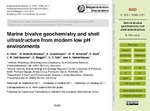Marine bivalve geochemistry and shell ultrastructure from modern low pH environments
| dc.contributor.author | Hahn, S | |
| dc.contributor.author | Rodolfo-Metalpa, R | |
| dc.contributor.author | Griesshaber, E | |
| dc.contributor.author | Schmahl, WW | |
| dc.contributor.author | Buhl, D | |
| dc.contributor.author | Hall-Spencer, Jason | |
| dc.contributor.author | Baggini, C | |
| dc.contributor.author | Fehr, KT | |
| dc.contributor.author | Immenhauser, A | |
| dc.date.accessioned | 2013-02-20T22:27:59Z | |
| dc.date.available | 2013-02-20T22:27:59Z | |
| dc.date.issued | 2011-10-24 | |
| dc.identifier.uri | http://hdl.handle.net/10026.1/1397 | |
| dc.description.abstract |
Bivalve shells can provide excellent archives of past environmental change but have not been used to interpret ocean acidification events. We investigated carbon, oxygen and trace element records from different shell layers in the mussels Mytilus galloprovincialis (from the Mediterranean) and M. edulis (from the Wadden Sea) combined with detailed investigations of the shell ultrastructure. Mussels from the harbour of Ischia (Mediterranean, Italy) were transplanted and grown in water with mean pHT 7.3 and mean pHT 8.1 near CO2 vents on the east coast of the island of Ischia. The shells of transplanted mussels were compared with M. edulis collected at pH ∼ 8.2 from Sylt (German Wadden Sea). Most prominently, the shells recorded the shock of transplantation, both in their shell ultrastructure, textural and geochemical record. Shell calcite, precipitated subsequently under acidified seawater responded to the pH gradient by an in part disturbed ultrastructure. Geochemical data from all test sites show a strong metabolic effect that exceeds the influence of the low-pH environment. These field experiments showed that care is needed when interpreting potential ocean acidification signals because various parameters affect shell chemistry and ultrastructure. Besides metabolic processes, seawater pH, factors such as salinity, water temperature, food availability and population density all affect the biogenic carbonate shell archive. | |
| dc.format.extent | 10351-10388 | |
| dc.language.iso | en | |
| dc.title | Marine bivalve geochemistry and shell ultrastructure from modern low pH environments | |
| dc.type | journal-article | |
| dc.type | Article | |
| plymouth.volume | 8 | |
| plymouth.journal | Biogeosciences Discussions | |
| plymouth.organisational-group | /Plymouth | |
| plymouth.organisational-group | /Plymouth/Faculty of Science and Engineering | |
| plymouth.organisational-group | /Plymouth/PRIMaRE Publications | |
| plymouth.organisational-group | /Plymouth/REF 2021 Researchers by UoA | |
| plymouth.organisational-group | /Plymouth/REF 2021 Researchers by UoA/UoA07 Earth Systems and Environmental Sciences | |
| plymouth.organisational-group | /Plymouth/Research Groups | |
| plymouth.organisational-group | /Plymouth/Research Groups/Marine Institute | |
| plymouth.organisational-group | /Plymouth/Users by role | |
| plymouth.organisational-group | /Plymouth/Users by role/Academics | |
| dcterms.dateAccepted | 2011-01-01 | |
| dc.rights.embargoperiod | Not known | |
| rioxxterms.licenseref.uri | http://www.rioxx.net/licenses/all-rights-reserved | |
| rioxxterms.type | Journal Article/Review |


